![]()
![]()
![]()
Use LEFT and RIGHT arrow keys to navigate between flashcards;
Use UP and DOWN arrow keys to flip the card;
H to show hint;
A reads text to speech;
292 Cards in this Set
- Front
- Back
|
Which bacteria are G+ with branching filaments? How do you distinguish them? |

- Actinomyces (anaerobe, not acids fast)
- Nocardia (aerobe, acid fast) |
|
|
Which bacteria are G+ rods? How do you distinguish some of them?
|

- Clostridium (anaerobe)
- Corynebacterium - Listeria - Bacillus (aerobe) - Mycobacterium (acid-fast) |
|
|
How do you distinguish the G+ cocci?
|

- Catalase test
- Coagulase test - Hemolysis |
|
|
Which bacteria are G+ and catalase +? How do you distinguish them?
|

Staphylococcus (clusters)
- Coagulase +: S. aureus - Coagulase -: Novobiocin sensitive S. epidermidis and Novobicin resistant S. saprophyticus |
|
|
Which bacteria are G+ and catalase -? How do you distinguish them?
|
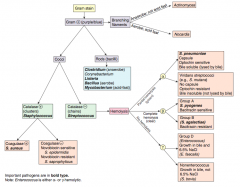
Streptococcus (chains)
- Distinguish based on hemolysis |
|
|
Which bacteria are G+, catalase +, and coagulase +? Organization?
|
S. aureus - cocci in clusters
|
|
|
Which bacteria are G+, catalase +, and coagulase -? Organization?
|

Clusters of cocci:
- Novobiocin sensitive S. epidermidis - Novobiocin resistant S. saprophyticus "NO StRESs": NOvobiocin - Saprophyticus is Resistant and Epidermidis is Sensitive |
|
|
Which bacteria are G+, catalase -, and have partial hemolysis (green)?
|

α-hemolytic Streptococcus (chains)
- S. pneumoniae - Viridans streptococci |
|
|
Which bacteria are G+, catalase -, and have complete hemolysis (clear)?
|

β-hemolytic Streptococcus (chains)
- Group A: S. pyogenes - Group B: S. agalactiae |
|
|
Which bacteria are G+, catalase -, and have no hemolysis?
|

γ-hemolytic Streptococcus (chains)
- Group D: Enterococcus - E. faecalis - Non-enterococcus: S. bovis |
|
|
What are the types of hemolysis?
|

- α-hemolysis: partial (forms green ring around colonies on blood agar)
- β-hemolysis: complete (forms clear area of hemolysis on blood agar) - γ-hemolysis: none |
|
|
What does α-hemolysis mean? What are the types of bacteria that fall under this category?
|

Partial hemolysis (green ring around colonies on blood agar)
*Streptococcus pneumoniae - Catalase (-) - Optochin sensitive - Capsule - Bile soluble (lysed by bile) *Viridans streptococci (eg, S. mutans) - Catalase (-) - Optochin resistant - No capsule - Bile insoluble (not lysed by bile) "OVRPS (overpass): Optochin - Viridans is Resistant; Pneumoniae is Sensitive |
|
|
What does β-hemolysis mean? What are the types of bacteria that fall under this category?
|

Comlete hemolysis (clear area around colonies on blood agar)
*Streptococcus pyogenes - Group A Strep - Catalase (-) - Bacitracin sensitive *Streptococcus agalactiae - Group B Strep - Catalase (-) - Bacitracin resistant "B-BRAS: Bacitracin - group B is Resistant, group A is Sensitive" *Staphylococcus aureus - Catalase (+) - Coagulase (+) *Listeria monocytogenes - Tumbling motility - Meningitis in newborns - Unpasteurized milk |
|
|
What does γ-hemolysis mean? What are the types of bacteria that fall under this category?
|

No hemolysis
*Enterococcus (E. faecalis) - Grows in bile and 6.5% NaCl - Group D *Non-Enterococcus (S. bovis) - Grows in bile, not 6.5% NaCl |
|
|
What does the "on the office's "staph" retreat, there was no stress" mnemonic mean?
|
Staphylococcus - NO StRESs:
Novobiocin - - Saprophyticus is Resistant - Epidermidis is Senstive |
|
|
What does the "overpass" mnemonic indicate?
|
OVRPS:
Optochin - Viridans is Resistant - Pneumoniae is Sensitive |
|
|
What does the "B-BRAS" mnemonic indicate?
|
B-BRAS
Bacitracin - Group B strep are Resistant - Group A strep are Sensitive |
|

Which bacteria:
- G+ cocci in clusters - Protein A (virulence factor) |

Staphylococcus aureus
|
|
|
Which virulence factor does Staphylococcus aureus use? Mechanism?
|
Protein A:
- Binds Fc-IgG - Inhibits complement activation and phagocytosis |
|
|
Where does Staphylococcus aureus colonize / infect?
|
- Commonly colonizes: nose
Inflammatory Disease: - Skin infections - Organ abscesses - Pneumonia (often after influenza virus infection) - Endocarditis - Osteomyelitis |
|
|
What does Staphylococcus aureus cause?
|
Inflammatory Disease:
- Skin infections - Organ abscesses - Pneumonia (often after influenza virus infection) - Endocarditis - Osteomyelitis Toxin-Mediated Disease - Toxic Shock Syndrome (TSST-1) - Scalded Skin Syndrome (Exfoliative Toxin) - Rapid-onset food poisoning (enterotoxins) MRSA (Methicillin-Resistant S. aureus) - Important cause of serious nosocomial and community-acquired infections - Resistant to methicillin and nafcillin because of altered penicillin binding protein |
|
|
What are the toxin mediated diseases of S. aureus? Toxin?
|
- Toxic Shock Syndrome (TSST-1)
- Scalded Skin Syndrome (Exfoliative Toxin) - Rapid-onset food poisoning (enterotoxins) |
|
|
What is an important cause of serious nosocomial and community-acquired infections?
|
MRSA (Methicillin-Resistant S. aureus)
- Resistant to methicillin and nafcillin because of altered penicillin binding protein |
|
|
What is TSST? Mechanism of action? What does it cause?
|
Toxic Shock Syndrome Toxin → Toxic Shock Syndrome
- Superantigen that binds to MHC II and T-Cell Receptor - Results in polyclonal T-cell activation - Presents as fever, vomiting, rash, desquamation, shock, and end-organ failure |
|
|
What predisposes to Toxic Shock Syndrome?
|
Use of vaginal or nasal tampons
|
|
|
Which bacteria causes rapid food poisoning? Mechanism?
|
S. aureus food poisoning is due to ingestion of preformed toxin (enterotoxins)
- Short incubation period (2-6 hours) - Enterotoxin is heat stable → not destroyed by cooking |
|
|
How does S. aureus form an abscess?
|
Forms fibrin clot around itself → abscess
|
|
|
Which bacteria is known for infection prosthetic devices and IV catheters? Mechanism?
|
Staphylococcus epidermidis
- Produces adherent biofilms to these medical devices |
|
|
Characteristics of Staphylococcus epidermidis?
|

Catalase (+), Coagulase (-)
- Infects prosthetic devices and IV catheters by producing adherent biofilms - Component of normal skin flora - Contaminates blood cultures - Novobiocin sensitive (No StRESs) |
|
|
Which bacteria are the first and second most common cause of uncomplicated UTI in young women?
|
1. E. coli
2. Staphylococcus saprophyticus |
|
|
Characteristics of Staphylococcus saprophyticus?
|

Catalase (+), Coagulase (-)
- 2nd most common cause of uncomplicated UTI in young women - Novobiocin resistant (No StRES) |
|
|
What does Streptococcus pneumoniae cause?
|
Most common cause of:
- Meningitis - Otitis media (in children) - Pneumonia - Sinusitis MOPS (MOPS also stands for Most are Optochin Sensitive) |
|
|
Characteristics of Streptococcus pneumoniae?
|

Catalase (-), α-hemolysis (partial)
- Lancet-shaped - G+ diplococci - Encapsulated (no virulence w/o capsule) - IgA protease - Optochin sensitive = OVRPS) |
|
|
What are the signs of Streptococcus pneumoniae?
|
- Rusty sputum
- Sepsis in sickle cell anemia - Splenectomy |
|
|
Which bacteria is a normal flora of the oropharynx and causes dental caries?
|
Streptococcus mutans (Viridans group Streptococci)
|
|
|
Which bacteria causes subacute bacterial endocarditis at damaged valves? Mechanism?
|
Streptococcus sanguinis (Viridans group Streptococci)
(sanguis = blood and the heart contains a lot of blood) - Makes dextrans which bind to fibrin-platelet aggregates on damaged heart valves |
|
|
Characteristics of Viridans groups Streptococci?
|

Streptococcus mutans & Streptococcus sanguinis
- α-Hemolytic - Resistant to optochin Viridans group strep live in the mouth because they are not afraid of-the-chin (op-to-chin resistant) |
|
|
What is the name of Group A Streptococci?
|
Streptococcus pyogenes
|
|
|
What does Streptococcus pyogenes cause?
|
Pyogenic infections:
- Pharyngitis - Cellulitis - Impetigo Toxigenic infections: - Scarlet fever - Toxic shock-like syndrome - Necrotizing fasciitis Immunologic infections: - Rheumatic fever - Acute glomerulonephritis |
|
|
What are the pyogenic infections caused by Streptococcus pyogenes?
|
- Pharyngitis
- Cellulitis - Impetigo |
|
|
What are the toxigenic infections caused by Streptococcus pyogenes?
|
- Scarlet fever
- Toxic shock-like syndrome - Necrotizing fasciitis |
|
|
What are the immunologic infections caused by Streptococcus pyogenes?
|
- Rheumatic fever
- Acute glomerulonephritis |
|
|
Characteristics of Streptococcus pyogenes?
|

Group A, β-hemolysis:
- Bacitracin sensitive - M protein |
|
|
What enhances host defenses against Streptococcus pyogenes?
|
Antibodies to M protein
|
|
|
How can you detect a Streptococcus pyogenes infections?
|
ASO titer detects recent S. pyogenes infection
|
|
|
What are the diagnostic criteria for Rheumatic Fever? Cause?
|
J♥︎NES criteria:
- Joints - polyarthritis - ♥︎ - carditis - Nodules (subcutaneous) - Erythema marginatum - Sydenham chorea Caused by Streptococcus pyogenes (group A) |
|
|
Untreated pharyngitis caused by Streptococcus pyogenes can lead to what?
|
- Rheumatic fever
- Glomerulonephritis |
|
|
Impetigo more commonly precedes what immunologic manifestation of S. pyogenes?
|
Impetigo more commonly precedes glomerulonephritis than pharyngitis
|
|
|
What are the symptoms and cause of Scarlet Fever?
|
Symptoms:
- Scarlet rash w/ sandpaper-like texture - Strawberry tongue - Circumoral pallor Cause: - Streptococcus pyogenes (group A streptococci) |
|
|
Which bacteria causes pneumonia, meningitis, and sepsis mainly in babies?
|
Streptococcus agalactiae (group B streptococci)
"Group B for Babies" |
|
|
Characteristics of Streptococcus agalactiae?
|

Group B, β-hemolysis:
- Bacitracin resistant (B-BRAS) - Hippurate test (+) |
|
|
Why does Streptococcus agalactiae (group B) commonly infect babies? Implications?
|
- It colonizes the vagina - then it is spread to babies during a vaginal birth
- Screen pregnant women at 35-37 weeks (patients w/ + culture receive intrapartum penicillin prophylaxis |
|
|
What is the mechanism of Streptococcus agalactiae (group B)?
|
- Produces CAMP factor
- Enlarges the area of hemolysis formed by S. aureus |
|
|
Which G+ bacteria is found in normal colonic flora and can cause UTIs, biliary tract infections, and subacute endocarditis (after GI/GU procedures)?
|
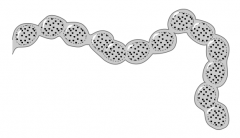
Enterococci faecalis and faecium (group D)
|
|
|
Characteristics of Enterococci?
|

Group D Streptococci
- G+ - Penicillin G resistant |
|
|
What kind of infections do Enterococci cause?
|
- UTI
- Biliary tract infections - Subacute endocarditis (following GI/GU procedures) |
|
|
What kind of bacteria are classified as Group D Streptococci? Difference?
|
Enterococci (E. faecalis and E. faecium)
- Can grow in 6.5% NaCl and bile (lab test) Non-enterococcal (S. bovis) - Can grow in bile but not 6.5% NaCl |
|
|
What determines whether a bacteria is Group A/B/C/D?
|
Lancefield grouping - based on differences in the C carbohydrate on the bacterial cell wall, variably hemolysis
|
|
|
What is an important cause of nosocomial infection by Enterococci?
|
VRE: Vancomycin-Resistant Enterococci
|
|
|
Which G+ bacteria is found in normal colonic flora and can cause bacteremia and subacute endocarditis in colon cancer patients?
|
Streptococcus bovis (group D)
|
|
|
Characteristics of Streptococcus bovis (group D)?
|
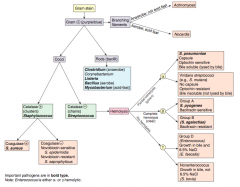
- Colonizes the gut
- Causes bacteremia and subacute endocarditis in colon cancer patients (Bovis in the Blood = Cancer in the Colon) - γ-hemolysis (no hemolysis) |
|

Which bacteria causes pseudomembranous pharyngitis (grayish-white membrane) w/ lymphadenopathy?
|
Corynebacterium diphtheriae - via exotoxin encoded by β-prophage, inhibits protein synthesis via ADP-ribosylation of EF-2
|
|
|
Which bacteria releases diphtheria exotoxin? Mechanism?
|
Corynebacterium diphtheriae - exotoxin encoded by β-prophage, inhibits protein synthesis via ADP-ribosylation of EF-2
ABCDEFG: - ADP-ribosylation - β-prophage - Corynebacterium - Diphtheriae - Elongation Factor 2 - Granules |
|
|
What are the symptoms of Corynebacterium diphtheriae infection?
|
- Pseudomembranous pharyngitis (grayish-white membrane)
- Lymphadenopathy - Myocarditis - Arrhythmias |
|
|
How do you diagnose Corynebacterium diphtheriae infection?
|
- G+ rods w/ metachromatic (blue and red) granules
- Elk test for diphtheria toxin - Black colonies on cystine-tellurite agar |
|
|
How can you prevent infection with Corynebacterium diphtheriae?
|
Toxoid vaccine
|
|
|
Which bacteria form spores?
|
Spore-forming G+ bacteria in soil:
- Bacillus anthracis - Clostridium perfringens - C. tetani Other spore formers: - B. cereus - C. botulinum - Coxiella burnetti |
|
|
What causes bacteria that form spores to make spores? Purpose?
|
- Form spores at the end of the stationary phase when nutrients are limited
- Spores are highly resistant to heat and chemicals |
|
|
What are the characteristics of spores?
|
- Highly resistant to heat and chemicals
- Have dipicolinic acid in their core - No metabolic activity |
|
|
How do you kill spores?
|
Must autoclave (as is done to surgical equipment) by steaming at 121°C for 15 minutes
|
|
|
Which bacteria are G+, spore-forming, obligate anaerobic bacilli?
|
Clostridia
- C. tetani - C. botulinum - C. perfringens - C. difficile |
|
|
What kind of toxin is produced by Clostridium tetani?
|
Tetanospasmin / Tetanus toxin (exotoxin)
|
|
|
What bacteria releases Tetanus toxin? Effects?
|
Clostridium tetani
- Protease that cleaves releasing proteins for NTs - Blocks glycine and GABA release (both are inhibitory NTs) from Renshaw cells in spinal cord - Causes spastic paralysis (tetanic), trismus (lockjaw), and risus sardonicus (spasm of facial muscles causing a grin) |
|
|
What is trismus? Cause?
|
Lockjaw - caused by Tetanus toxin from Clostridium tetani
|
|
|
What is Risus Sardonicus? Cause?
|
Spasm of facial muscles causing a grin - caused by Tetanus toxin from Clostridium tetani
|
|
|
What kind of toxin is produced by Clostridium botulinum?
|
Preformed, heat-labile toxin
|
|
|
What bacteria releases a preformed, heat-labile toxin? Effects?
|
Clostridium botulinum
- Inhibits ACh release at neuromuscular junction, causing botulism |
|
|
How does C. botulinum infect adults? Infants?
|
"BOTulinum is from bad BOTtles of food and honey)
- Adults: disease is caused by ingestion of preformed toxin - Babies: disease is caused by ingestion of spores in honey → floppy baby syndrome |
|
|
Why shouldn't babies eat honey?
|
- Honey can contain spores from C. botulinum
- Ingestion of spores causes floppy baby syndrome (toxin inhibits ACh release at neuromuscular junction causing botulism) |
|
|
What kind of toxin is produced by Clostridium perfringens?
|
α-Toxin ("lecithinase" a phospholipase)
|
|
|
What bacteria releases α-Toxin? Effects?
|
Clostridium perfringens
- α-Toxin - a phospholipase - Causes myonecrosis (gas gangrene) and hemolysis - Perfringens perforates a gangrenous leg "PERFringens PERForates a gangrenous leg" |
|
|
What kind of toxin is produced by Clostridium difficile?
|
Produces 2 toxins
- Toxin A (enterotoxin) - Toxin B (cytotoxin) |
|
|
What bacteria releases Toxin A? Effects?
|
Clostridium difficile
- Enterotoxin - Binds to brush border of gut |
|
|
What bacteria releases Toxin B? Effects?
|
Clostridium difficile
- Cytotoxin - Causes cytoskeletal disruption via actin depolymerization → pseudomembranous colitis → diarrhea |
|
|
What often precedes infection by Clostridium difficile? Symptoms?
|
- Often secondary to antibiotic use, especially clindamycin or ampicillin
- Causes diarrhea |
|
|
How do you diagnose Clostridium difficile infection? Treat?
|
Diagnose:
- Detection of one or both toxins in stool (Toxin A / enterotoxin or Toxin B / cytotoxin) Treat: - Metronidazole or oral vancomycin - Recurring cases: fecal transplant may prevent relapse |
|
|
What is the only bacterium with a polypeptide capsule (contains D-glutamate)?
|
Bacillus anthracis
|
|
|
Which bacteria causes Anthrax? Characteristics?
|

Bacillus anthracis
- G+, spore-forming rod - Produces anthrax toxin - Only bacterium with a polypeptide capsule (contains D-glutamate) |
|
|
What are the forms of infection caused by Bacillus anthracis?
|
- Cutaneous anthrax
- Pulmonary anthrax |
|
|
What are the symptoms of Cutaneous Anthrax?
|

- Boil like lesion → ulcer with black eschar (painless, necrotic)
- Uncommonly progresses to bacteremia and death |
|
|
What are the symptoms of Pulmonary Anthrax?
|
- Inhalation of spores → flu-like symptoms
- Rapidly progresses to fever, pulmonary hemorrhage, mediastinitis, and shock |
|
|
What is the term for Pulmonary Anthrax caused by inhalation of spores from contaminated wool?
|
Woolsorters' Disease
|
|
|
Which bacteria causes food poisoning commonly from reheated rice?
|
Bacillus cereus
|
|
|
What kind of infection is caused by Bacillus cereus? Source of infection?
|
- Food poisoning: spores survive cooking rice, keeping rice warm results in germination of spores and enterotoxin formation
- Emetic type usually seen w/ rice and pasta (nausea and vomiting within 1-5 hours), d/t cereulide (preformed toxin) - Diarrheal type causes watery, non-bloody diarrhea and GI pain w/in 8-18 hours |
|
|
What is responsible for the emetic type of food poisoning due to Bacillus cereus? How soon?
|
Cereulide (preformed toxin) in rice and pasta, causes symptoms within 1-5 hours
|
|
|
How quickly do diarrheal type symptoms from Bacillus cereus occur?
|
Within 8-18 hours
|
|
|
What bacteria can be found in unpasteurized dairy products and infected deli meats?
|
Listeria monocytogenes
|
|
|
Characteristics of Listeria monocytogenes?
|

- G+ facultative intracellular microbe
- Produces LPS (only G+ organism to do so) |
|
|
How can Listeria monocytogenes be acquired?
|
- Ingestion of unpasteurized dairy products and deli meats
- Transplacental transmission - Vaginal transmission during birth |
|
|
How does Listeria monocytogenes avoid host defenses?
|
- Avoids antibody by forming "rocket tails" (via actin polymerization) that allows them to move through the cytoplasm and into the cell membrane
- Characteristic tumbling motility |
|
|
What can infection with Listeria monocytogenes cause?
|
- Amnionitis, septicemia, and spontaneous abortion in pregnant women
- Granulomatosis infantiseptica - Neonatal meningitis - Meningitis in immunocompromised patients - Mild gastroenteritis in healthy individuals |
|
|
What does Listeria monocytogenes cause in healthy patients? How do you treat?
|
Gastroenteritis (mild) - usually self-limited
|
|
|
What does Listeria monocytogenes cause in pregnant patients?
|
- Amnionitis
- Septicemia - Spontaneous abortion |
|
|
What does Listeria monocytogenes cause in infants patients? How do you treat?
|
- Granulomatosis infantiseptica
- Neonatal meningitis (treat with Ampicillin) |
|
|
What does Listeria monocytogenes cause in immunocompromised patients? How do you treat?
|
Meningitis (treat empirically with Ampicillin)
|
|
|
Which bacteria form long, branching filaments resembling fungi?
|
- Actinomyces
- Nocardia |
|

Which bacteria causes oral/facial abscesses that drain through sinus tracts forming yellow "sulfur" granules? How do you treat?
|

Actinomyces - treat with Penicillin
|
|
|
Characteristics of Actinomyces?
|

- G+ anaerobe
- Forms long-branching filaments that resemble fungi - Not acid fast - Normal oral flora - Causes oral/facial abscesses that drain through sinus tracts forming yellow "sulfur granules" - Treat with Penicillin |
|
|
Which bacteria causes pulmonary infections in immunocompromised patients and cutaneous infections after trauma in immunocompromised patients? How do you treat?
|
Nocardia - treat with Sulfonamides
|
|
|
Characteristics of Nocardia?
|

- G+ aerobe
- Forms long, branching filaments resembling fungi - Acid fast (weak) - Found in soil - Causes pulmonary infections in immunocompromised patients - Causes cutaneous infections after trauma in immunocompromised patients - Treat with Sulfonamides |
|
|
What causes Tuberculosis? Different forms of infection?
|

Infection with Mycobacterium tuberculosis
- Primary infection: non-immune host (usually a child) - Secondary infection: partially immune hyper-sensitized host (usually adult) |
|
|
What are the signs of a Primary Tuberculosis?
|

Occurs in a non-immune host (usually a child)
- Ghon Complex: Hilar nodes & Ghon focus (usually in mid zone of lung) |
|
|
What can Primary Tuberculosis lead to?
|

- Heals by fibrosis → immunity and hypersensitivity → Tuberculin (+)
- Progressive lung disease (HIV, malnutrition) → death (rare) - Severe bacteremia → miliary tuberculosis → death - Pre-allergic lymphatic or hematogenous dissemination → dormant tubercle bacilli in several organs → REACTIVATION in adult life |
|
|
What are the signs of a Secondary Tuberculosis?
|

Fibrocaseous cavitary lesion (usually in upper lobes)
|
|
|
What can Secondary Tuberculosis lead to?
|

Extrapulmonary Tuberculosis
- CNS: parenchymal tuberculoma or meningitis - Vertebral body: Pott disease - Lymphadenitis - Renal - GI - Adrenals |
|
|
What does a positive PPD test mean?
|
Either:
- Current infection with Mycobacterium tuberculosis - Past exposure to Mycobacterium tuberculosis - BCG vaccinated |
|
|
What does a negative PPD test mean?
|
Either:
- No infection - Anergic (steroids, malnutrition, immunocompromise) and in sarcoidosis |
|
|
Which test is more specific than PPD for Mycobacterium tuberculosis infection?
|
Interferon-γ Release Assay (IGRA)
- More specific - Fewer false positives from BCG vaccination |
|
|
Which vaccine is used to prevent Tuberculosis?
|
BCG vaccine
|
|
|
What is the appearance of a caseating granuloma in tuberculosis infection?
|

- Central necrosis (pinkish region in upper left)
- Multinucleated Langhans giant cell (arrow) |
|
|
What are the symptoms of TB?
|
- Fever
- Night sweats - Weight loss - Hemoptysis |
|
|
What are the species of Myocbacterium? What disease do they cause?
|
- M. tuberculosis (TB, often resistant to multiple drugs)
- M. kansasii (pulmonary TB-like symptoms) - M. avium-intracellulare (causes disseminated, non-TB disease in AIDS; often resistant to multiple drugs; prophylactic tx with azithromycin) - M. leprae (Leprosy / Hansen disease) |
|
|
What are the characteristics of all Mycobacteria?
|

All are acid-fast organisms
|
|
|
Which bacteria causes disseminated, non-TB disease in AIDS patients? Treatment / prevention?
|
Mycobacterium avium-intracellulare
- Often resistant to multiple drugs - Prophylactic treatment with Azithromycin |
|
|
What is released by virulent strains of Mycobacteria? Implication?
|
Cord fator is found in virulent strains
- Inhibits macrophage maturation - Induces release of TNF-α Sulfatides (surface glycolipids) - Inhibit phagolysosomal fusion |
|

Which bacteria causes this appearance?
|
Mycobacterium leprae (Leprosy / Hansen disease)
|
|
|
Characteristics of Mycobacterium leprae?
|

- Acid-fast bacillus
- Likes cool temperatures - Cannot be grown in vitro - Reservoir in US: armadillos |
|
|
What does Mycobacterium leprae infect?
|

- Skin
- Superficial nerves: "glove and stocking" loss of sensation - Armadillos (reservoir) |
|
|
What are the forms of Leprosy / Hansen disease? Characteristics?
|

Lepromatous:
- Diffuse presentation over skin - Leonine (lion-like) facies - Communicable - Characterized by low cell-mediated immunity w/ a humoral Th2 response Tuberculoid: - Limited to a few hypoesthetic, hairless skin plaques - Characterized by high cell-mediated immunity with a largely Th1 type immune response |
|
|
Which form of Leprosy has a LOW cell-mediated immunity with a humoral Th2 response?
|
Lepromatous form
|
|
|
Which form of Leprosy has a HIGH cell-mediated immunity with a largely Th1-type immune response?
|
Tuberculoid form
|
|
|
How do you treat the two forms of Leprosy / Hansen disease?
|
Lepromatous form:
- Dapsone, Rifampin, and Clofazimine for 2-5 years Tuberculoid form: - Dapsone and Rifampin for 6 months |
|
|
How should you first distinguish G- (pink) bacteria?
|

Shape
- Diplococci - "Coccoid" rods - Rods - Oxidase (+) comme shaped |
|
|
Which bacteria are G- diplococci? How do you distinguish them?
|

Distinguish based on ability to ferment maltose
- Neisseria meningitidis (ferments maltose - meningitiids starts with "m") - Neisseria gonorrhoeae (non-fermenter) |
|
|
Which bacteria are G- coccoid rods? How do you distinguish them?
|

* Haemophilus influenzae (requires factors V and X)
* Bordetella pertussis - Pasteurella (animal bites) - Brucella (brucellosis) |
|
|
Which bacteria are G- rods? How do you distinguish them?
|

Distinguish based on ability to ferment lactose and distinguish non-fermenters by oxidase capability:
Lactose fermenters: - Fast: Klebsiella, E. coli, Enterobacter - Slow: Citrobacter, Serratia, etc. Lactose non-fermenters: - Oxidase (+): Pseudomonas - Oxidase (-): Shigella, Salmonella, Proteus, Yersinia |
|
|
Which bacteria are lactose fermenting G- rods? How do you distinguish them?
|

Fast fermenters:
* Klebsiella * E. coli - Enterobacter Slow fermenters: - Citrobacter - Serratia Lactose is "KEE" - Test with Mac"C"on"KEE'S" agar |
|
|
Which bacteria are non-lactose fermenting G- rods? How do you distinguish them?
|

Oxidase (+):
- Pseudomonas Oxidase (-): - Shigella - Salmonella - Proteus - Yersinia |
|
|
Which bacteria are oxidase (+), comma shaped G-? How do you distinguish them?
|

Grows in 42°C:
- Campylobacter jejuni Grows in alkaline media: - Vibrio cholerae Produces urease: - Helicobacter pylori |
|
|
How do you determine if a bacteria can ferment lactose?
|

*If it can grow pink colonies on MacConkey agar
Remember macConKEE'S agar to remember which bacteria can ferment lactose - - Citrobacter (slow) - Klebsiella (fast) - E. coli (fast) - Enterobacter (fast) - Serratia (slow) *Can also test on EMB agar - lactose fermenters grow as purple/black colonies (E. coli grows purple colonies w/ a green sheen) |
|
|
Can E. coli ferment lactose? Why or why not?
|
Yes - E. coli produces β-galactosidase, which breaks down lactose into glucose and galactose
|
|
|
G- bacilli are resistant to what antibiotics? What are they susceptible to?
|
- Resistant to Penicillin G and Vancomycin (G- outer membrane layer inhibits entry)
- Susceptible to Penicillin derivatives such as Ampicillin and Amoxicillin |
|
|
Neisseria species are what type of bacteria? What can they ferment?
|

G- diplococci
- MeninGococci ferment both Maltose and Glucose (meningitidis) - Gonococci ferment Glucose (gonorrhoeae) |
|
|
What do Neisseria species produce?
|
IgA proteases
|
|
|
Which bacteria is sexually transmitted and can also cause septic arthritis, neonatal conjunctivitis, pelvic inflammatory disease (PID), and Fitz-Hugh-Curtis Syndrome? Treatment?
|
Neisseria gonorrhoeae
Treat: Ceftriaxone (+ Azithromycin or Doxycycline for possible Chlamydia co-infection) |
|
|
Characteristics of Neisseria gonorrhoeae?
|

G- diplococci
- Produces IgA proteases - Ferments glucose only - Often intracellular (within neutrophils) - No polysaccharide capsule - No vaccine (d/t rapid antigenic variation of pilus proteins) |
|
|
What can Neisseria gonorrhoeae infection cause? Prevention?
|
Prevent sexual transmission w/ condoms
- Gonorrhea - Septic arthritis - Neonatal conjunctivitis (prevent transmission w/ erythromycin ointment) - Pelvic Inflammatory Disease (PID) - Fitz-Hugh-Curtis Syndrome |
|
|
Which bacteria is spread via respiratory and oral secretions, causing meningococcemia and meningitis as well as Waterhouse-Friderichsen syndrome? Treatment?
|
Neisseria meningitidis
Treat: Ceftriaxone or Penicillin G |
|
|
Characteristics of Neisseria meningitidis?
|

G- diplococci
- Produces IgA proteases - Ferments glucose AND maltose - Polysaccharide capsule - Vaccine (none for type B) - Spread via respiratory and oral secretions |
|
|
What can Neisseria meningitidis infection cause? Prevention?
|
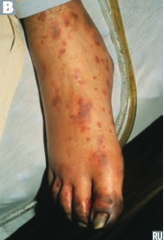
- Meningococcemia (picture)
- Meningitis - Waterhouse-Friderichsen syndrome Prevent: Rifampin, Ciprofloxacin, or Ceftriaxone prophylaxis in close contacts (Ceftriaxone or Penicillin G can be used for treatment) |
|

Which bacteria causes an infection that leads to the "thumbprint sign" on lateral neck radiograph?
|
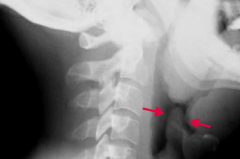
Haemophilus influenzae epiglottitis
|
|
|
Characteristics of Haemophilus influenzae?
|
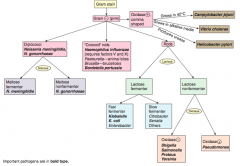
Small G- coccobacillary rod
- Aerosol transmission - Most invasive disease caused by capsular type B - Produces IgA protease - Culture on chocolate agar requires factors V (NAD+) and X (Hematin) for growth |
|
|
Which type of Haemophilus influenzae causes the most invasive disease? What do the other types cause?
|
- Most invasive disease caused by capsular type B
- Nontypeable strains cause mucosa infections (eg, otitis media, conjunctivitis, or bronchitis) |
|
|
What kind of infection is caused by Haemophilus influenzae?
|
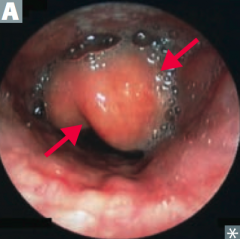
HaEMOPhilus causes
- Epiglottitis ("cherry red" in children) - Meningitis - Ototis media - Pneumonia |
|
|
How do you culture Haemophilus influenzae?
|
On Chocolate agar, requires:
- Factor V (NAD+), also can be grown w/ S. aureus which provides Factor V - Factor X (hematin) "When a child has "flu", mom goes to five (V) and dime (X) store to buy some chocolate" |
|
|
How do you treat Haemophilus influenzae infections?
|
- Mucosal infections (eg, otitis media, conjunctivitis, bronchitis) with Amoxicillin +/- Clavulanate
- Meningitis with Ceftriaxone |
|
|
How do you prevent spread / infection of Haemophilus influenzae infections?
|
- Prevention in close contacts exposed to AEROSOL TRANSMISSION: Rifampin
- Prevention w/ vaccine: contains type B capsular polysacchardie (polyribosylribitol phosphate) conjugated to diphtheria toxoid or other protein (given between 2-18 months) |
|
|
Which bacteria causes severe pneumonia, fever, GI and CNS symptoms?
|
Legionella pneumophila (Legionnaire's disease)
|
|
|
Characteristics of Legionella pneumophila?
|

G- rod
- Gram stains poorly (use SILVER stain) - Grow on CHARCOAL yeast extract culture with IRON and CYSTEINE - Detected clinically by presence of antigen in urine - Aerosol transmission from environmental water source habitat (eg, AC systems, hot water tanks); no person-to-person transmission "Think of a French LEGIONNAIRE (soldier) with his SILVER helmet, sitting around a campfire (CHARCOAL) with his IRON dagger - his is no SISSY (CYSTEINE)" |
|
|
How do you diagnose Legionella pneumophila? Other signs?
|
* Presence of antigen in urine is used clinically
- Labs show hyponatremia - G- rod, better stained w/ Silver Stain - Cultured on Charcoal yeast extract with Iron and Cysteine |
|
|
How does Legionella pneumophila get spread?
|
- Aerosol transmission from environmental water source habitat (eg, A/C systems, hot water tanks)
- Not person-to-person |
|
|
What disease states can Legionella pneumophila infection cause? Treatment?
|
- Legionnaires' Disease: severe pneumonia, fever, GI and CNS symptoms
- Pontiac Fever: mild flu-like syndrome - Treat: Macrolide or Quinolone |
|
|
Which bacteria is associated with wound and burn infections?
|
Pseudomonas aeruginosa
|
|
|
Characteristics of Pseudomonas aeruginosa?
|

G- Rod:
- Aerobic (AERuginosa - Non-lactose fermenting - Oxidase (+) - Produces pyocyanin (blue-green pigment) - Grape-like odor - Water source - Produces endotoxin (fever, shock) and exotoxin A (inactivates EF-2) |
|
|
What toxins does Pseudomonas aeruginosa produce? Effects?
|
- Endotoxin → fever and shock
- Exotoxin A → inactivates EF-2 |
|
|
What color is Pseudomonas aeruginosa? How?
|

Blue/green pigment called Pyocyanin
|
|
|
What kind of infections does Pseudomonas aeruginosa cause?
|
PSEUDOmonas associated with wound and burn infections:
- Pneumonia (especially in cystic fibrosis) - Sepsis - External otitis (swimmer's ear) - UTI - Drug use - Diabetic Osteomyelitis (and malignant otitis externa in diabetics) - And hot tub folliculitis |
|
|
Which bacteria causes hot tub folliculitis?
|
Pseudomonas aeruginosa
|
|
|
How does Pseudomonas aeruginosa affect immunocompromised patients?
|

Ecthyma gangrenosum
- Rapidly progressive - Large ulcer (arrows) - Necrotic cutaneous lesions (arrowheads) |
|
|
What bacteria is associated with chronic pneumonia in cystic fibrosis patients?
|
Pseudomonas aeruginosa (associated with biofilms)
|
|
|
What are the virulence factors of E. coli?
|
- Fimbriae
- K capsule - LPS endotoxin |
|
|
What kind of infections are enhanced by the E. coli virulence factor "fimbriae"?
|
- Cystitis
- Pyelonephritis |
|
|
What kind of infections are enhanced by the E. coli virulence factor "K capsule"?
|
- Pneumonia
- Neonatal meningitis |
|
|
What kind of infections are enhanced by the E. coli virulence factor "LPS endotoxin"?
|
Septic shock
|
|
|
What are the strains of E. coli?
|
- EIEC
- ETEC - EPEC - EHEC |
|
|
Which bacteria causes invasive dysentery (severe diarrhea with the presence of blood and mucus in the feces)? Mechanism?
|
EIEC (Invasive)
- Microbe invades intestinal mucosa and causes necrosis and inflammation - Clinical manifestation is similar to Shigella |
|
|
Which bacteria causes Travelers' Diarrhea (watery)? Mechanism?
|
ETEC (Travelers')
- Produces heat-labile and heat-stable enteroToxins - No inflammation or invasion |
|
|
Which bacteria causes diarrhea usually in children? Mechanism?
|
EPEC (Pediatrics)
- No toxin produced - Adheres to apical surface - Flattens villi - Prevents absorption |
|
|
Which bacteria causes non-invasive dysentery (severe diarrhea with the presence of blood and mucus in the feces)? Mechanism?
|
EHEC (O157:H7 is the most common serotype)
- Produces Shiga-like toxin → Hemolytic-Uremic Syndrome - AKA STEC (Shiga Toxin-producing E. Coli) - Microthrombi form on endothelium damaged by toxin → mechanical hemolysis (forms schistocytes) and ↓ renal blood flow - Microthrombi consume platelets → thrombocytopenia |
|
|
What are the components of Hemolytic Uremic Syndrome? Cause?
|
- Anemia
- Thrombocytopenia - Acute renal failure - Caused by EHEC - Microthrombi form on endothelium damaged by toxin → mechanical hemolysis (forms schistocytes) and ↓ renal blood flow - Microthrombi consume platelets → thrombocytopenia |
|
|
What is the difference between EIEC and EHEC?
|
- EIEC: invasive, the microbe invades intestinal mucosa, causing necrosis and inflammation leading to dysentery
- EHEC: not-invasive, toxin alone causes necrosis and inflammation leading to dysentery |
|
|
Besides the presentation and mechanism, how does EHEC differ from other forms of E. coli?
|
Does not ferment sorbitol
|
|
|
Which form of E. coli does not ferment sorbitol?
|
EHEC
|
|
|
Which bacteria is associated with the 4 A's (Aspiration pneumonia, Abscess in lungs and liver, Alcoholics, and di-A-betics)?
|
Klebsiella
|
|
|
Characteristics of Klebsiella?
|

G- Rod
- Fast lactose fermenter - Part of intestinal flora |
|
|
What does Klebsiella cause? Who is affected?
|
*Causes lobar pneumonia (via Aspiration)
- Forms Abscesses in lungs and liver - Common in Alcoholics and di-A-betics - Forms mucoid colonies d/t abundant polysaccharide capsules - Red "currant jelly" sputum (remember 4 A's) *Also cause of nosocomial UTIs |
|
|
Which bacteria causes patients to have a lobar pneumonia that leads to red "currant jelly" sputum?
|
Klebsiella
|
|
|
What are the similarities of Salmonella and Shigella?
|
G- rods
- Invades intestinal mucosa and cause bloody diarrhea - Do not ferment lactose - Oxidase (-) |
|
|
How do Salmonella and Shigella differ in movement?
|
Salmonella:
- Flagella (salmon swim) Shigella: - No flagella |
|
|
How do Salmonella and Shigella differ in dissemination?
|
Salmonella
- Hematogenously (salmon swimming) Shigella - Cell-to-cell transmission - No hematogenous spread |
|
|
How do Salmonella and Shigella differ in reservoirs?
|
Salmonella
- Many animal reservoirs (salmon is an animal) Shigella - Only in humans and primates |
|
|
How do Salmonella and Shigella differ in production of hydrogen sulfide?
|
Salmonella
- Produces hydrogen sulfide Shigella - Does not produce hydrogen sulfide |
|
|
How do Salmonella and Shigella differ in their response to antibiotics?
|
Salmonella
- Antibiotics may PROLONG fecal excretion of organism Shigella - Antibiotics SHORTEN duration of fecal excretion of organism |
|
|
How do Salmonella and Shigella differ in their immune system response?
|
Salmonella
- Invades intestinal mucosa and causes a MONOCYTIC response Shigella - Invades intestinal mucosa and causes a PMN infiltration |
|
|
Which disease is characterized by rose spots on the abdomen, fever, headache, and diarrhea and can remain in the gallbladder causing a carrier state? Cause?
|
Typhoid Fever (caused by Salmonella typhi) - only found in humans
|
|
|
What are the symptoms of Typhoid Fever (Salmonella typhi)?
|
- Rose spots on abdomen
- Fever - Headache - Diarrhea - Can remain in gallbladder and cause a carrier state |
|
|
Characteristics of Salmonella?
|

- Flagella (salmon swim)
- Can disseminate hematogenously - Have many animal reservoirs - Produce hydrogen sulfide - Antibiotics may PROLONG fecal excretion of organism - Invades intestinal mucosa and causes a monocytic response - Can cause bloody diarrhea - Does not ferment lactose |
|
|
Characteristics of Shigella?
|

- No flagella
- Cell to cell transmission, no hematogenous spread - Only reservoirs are humans and primates - Does not produce hydrogen sulfide - Antibiotics shorten duration of fecal excretion of organism - Invades intestinal mucosa and causes a PMN infiltration - Often causes bloody diarrhea - Does not ferment lactose |
|
|
What bacteria is a major cause of bloody diarrhea (especially in children), and is spread through foods such as poultry, meat, and unpasteurized milk?
|
Campylobacter jejuni
|
|
|
Characteristics of Campylobacter jejuni?
|

G- Comma or S-shaped
- Oxidase (+) - Grows at 42°C ("Campylobacter likes the hot campfire") |
|
|
How is Campylobacter jejuni acquired?
|
Fecal-oral transmission through foods such as:
- Poultry - Meat - Unpasteurized milk |
|
|
What does Campylobacter jejuni cause?
|
- Major cause of bloody diarrhea (especially in children)
- Common antecedent to Guillain-Barré syndrome and reactive arthritis |
|
|
Which bacteria produces profuse "rice-water diarrhea"? Mechanism? Treatment?
|
Vibrio cholerae
- Enterotoxin permanently activates Gs → ↑cAMP → rice-water diarrhea - Treat with prompt oral rehydration |
|
|
Characteristics of Vibrio cholerae?
|
G- comma shaped
- Oxidase (+) - Grows in alkaline media |
|
|
Where is Vibrio cholerae more common? Treatment?
|
- Endemic to developing countries
- Prompt oral rehydration is necessary |
|
|
Which bacteria causes mesenteric adenitis that can mimic Crohn disease or appendicitis? Transmission?
|
Yersinia enterocolitica
- Transmitted from pet feces (eg, puppies), contaminated milk, or pork |
|
|
What disease does Yersinia enterocolitica cause? Transmission?
|
- Mesenteric adenitis that can mimic Crohn disease or appendicitis
- Transmitted from pet feces (eg, puppies), contaminated milk, or pork |
|
|
Which bacteria causes gastritis and peptic ulcers (especially duodenal)?
|
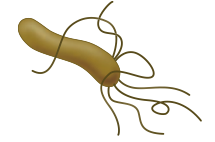
Helicobacter pylori
|
|
|
Characteristics of Helicobacter pylori?
|

G- comma shaped rods
- Oxidase (+) - Catalase (+) - Urease (+) - can use urea breath test or fecal antigen test - Creates alkaline environment |
|
|
What does Helicobacter pylori cause?
|
- Causes Gastritis and Peptic Ulcers (especially duodenal)
- Risk factor for gastric adenocarcinoma - Risk factor for lymphoma |
|
|
How do you treat Helicobacter pylori infection?
|
Triple therapy:
- Proton Pump Inhibitor (PPI) - Clarithromycin - Amoxicillin or Metronidazole |
|

What is the name for spiral-shaped bacteria? Types? Visualization?
|
Spirochetes: BLT -
- Borrelia (big size - only spirochete that can be visualized using aniline dyes (Wright or Giemsa stain) with light microscopy) - Leptospira - Treponema (visualized with dark-field microscopy) |
|
|
Which type of bacteria can be visualized with dark-field microscopy?
|
Treponema (type of spirochete)
|
|
|
Which type of bacteria is found in water contaminated with animal urine?
|
Leptospira interrogans
|
|
|
What diseases are caused by Leptospira interrogans infection?
|
Leptospirosis
- Flu-like symptoms - Jaundice - Photophobia - Conjunctival suffusion (erythema without exudate) Weil Disease (icterohemorrhagic leptospirosis) - Severe form with jaundice and azotemia from liver and kidney dysfunction - Fever - Hemorrhage - Anemia |
|
|
What is the cause and symptoms of Leptospirosis?
|
Leptospira interrogans
- Flu-like symptoms - Jaundice - Photophobia - Conjunctival suffusion (erythema without exudate) |
|
|
What is the cause and symptoms of Weil Disease?
|
Caused by Leptospira interrogans
AKA icterohemorrhagic leptospirosis - Severe form of leptospirosis with jaundice and azotemia from liver and kidney dysfunction - Fever - Hemorrhage - Anemia |
|
|
Who is more likely to get infected with Leptospira interrogans (which causes leptospirosis and Weil disease)?
|
Prevalent among surfers and in tropics (eg, Hawaii)
|
|
|
What causes Lyme Disease?
|
* Borrelia burgdorferi, which is transmitted by the tick Ixodes (also vector for Babesia)
- Natural reservoir is the mouse (important for tick life cycle) |
|
|
Where is Lyme disease more common?
|
NE United States
|
|
|
What are the initial symptoms of Lyme Disease (Borrela burgdorferi)?
|

- Erythema chronicum migrans - expanding bulls eye red rash (picture)
- Flu-like symptoms - +/- Nerve palsy |
|
|
What are the later symptoms of Lyme Disease (Borrela burgdorferi)?
|
- Monoarthritis (large joints)
- Migratory polyarthritis - Cardiac - AV nodal block - Neurologic - encephalopathy, facial nerve palsy, polyneuropathy |
|
|
What mnemonic can you use to remember the symptoms of Lyme Disease?
|
FAKE a Key LYME pie:
- Facial nerve palsy (typically bilateral) - Arthritis - Kardiac block - Erythema migrans |
|
|
How do you treat Lyme Disease (Borrelia burgdorferi)?
|
Doxycycline and Ceftriaxone
|
|
|
What bacteria causes Syphilis?
|
Treponema pallidum (spirochete)
|
|
|
What are the stages of Syphilis?
|
- 1° Syphilis
- 2° Syphilis - 3° Syphilis - Congenital Syphilis |
|
|
What are the signs of 1° Syphilis?
|
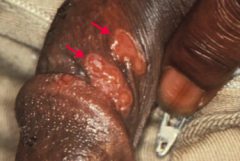
Localized disease, presents with PAINLESS chancre
|
|
|
What are the microscopic and lab findings of 1° Syphilis?
|
- Dark-field microscopy can visualize treponemes in fluid from chancre
- Serologic testing: VDRL/RPR (non-specific), confirm diagnosis with specific test (eg, FTA-ABS) |
|
|
What are the signs of 2° Syphilis?
|
- Disseminated disease / Systemic
- Constitutional symptoms - Maculopapular rash (palms and soles) - Condylomata lata (wart like lesions on the genitals) |
|
|
What are the microscopic and lab findings of 2° Syphilis?
|
- Dark-field microscopy can visualize treponemes
- Serologic testing: VDRL/RPR (non-specific), confirm diagnosis with specific test (eg, FTA-ABS) |
|
|
Following the systemic (2° stage) of syphilis, what happens?
|
Latent syphilis stage
- Positive serology without symptoms |
|
|
What are the signs of 3° Syphilis?
|
- Gummas (chronic granulomas)
- Aortitis (vasa vasorum destruction) - Neurosyphilis (tabes dorsalis, "general paresis") - Argyll Robertson pupil (constricts w/ accommodation but not reactive to light) - Broad-based ataxia - (+) Romberg's test - Charcot joint (progressive degeneration of a weight bearing joint, marked by bony destruction, bone resorption, and eventual deformity) - Stroke without hypertension |
|
|
What are the lab findings of 3° Syphilis?
|
For neurosyphilis: test spinal fluid with VDRL or RPR
|
|
|
What are the signs of congenital syphilis?
|
- Saber shins
- Saddle nose - CN VIII deafness - Hutchinson teeth - Mulberry molars (spreads typically after first trimester) |
|
|
How do you prevent syphilis and congenital syphilis?
|
*Treat with Penicillin G
- Prevent congenital syphilis: treat mother early in pregnancy, as placental transmission typically occurs after 1st trimester |
|
|
What is the "Prostitute Pupil"? AKA? Sign of?
|
Argyll Robertson Pupil
- Pupil constricts with accommodation but is not reactive to light - Associated with 3° syphilis |
|
|
What is the VDRL test used for? Utility?
|
Detects non-specific antibody that reacts with beef cardiolipin; widely used for syphilis (quantitative, sensitive, but not specific)
False positives can be caused by: - Viruses (mono, hepatitis) - Drugs - Rheumatic fever - Lupus and leprosy |
|
|
What is the term for flu-like syndrome that begins after antibiotics are started? Why?
|
Jarish-Herxheimer Reaction
- Due to killed bacteria releasing pyrogens (produces fever) |
|
|
What is the Jarish-Herxheimer Reaction?
|
- Causes flu-like syndrome that begins after antibiotics are started
- Due to killed bacteria releasing pyrogens (produces fever) |
|
|
What is the term for infectious disease transmitted between animals and humans?
|
Zoonosis
|
|
|
Which zoonotic species is transmitted by Ixodes ticks? Source? Disease?
|

Anaplasma species
- Live on deer and mice - Causes anaplasmosis Borrelia burgdorferi - Lives on deer and mice - Causes Lyme disease |
|
|
Which zoonotic species is transmitted by a cat scratch? Disease?
|
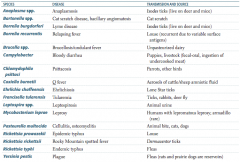
Bartonella species
- Cat scratch disease, bacillary angiomatosis |
|
|
Which zoonotic species is transmitted by louse? Disease?
|

Borrelia recurrentis
- Relapsing fever - Recurrent due to variable surface antigens Rickettsia prowazekii - Epidemic typhus |
|
|
Which zoonotic species is transmitted by unpasteurized dairy? Disease?
|

Brucella specia
- Brucellosis / undulant fever |
|
|
Which zoonotic species is transmitted by puppies and livestock? Source? Disease?
|

Campylobacter
- Fecal-oral transmission via ingestion of undercooked meat - Bloody diarrhea |
|
|
Which zoonotic species is transmitted by parrots and other birds? Disease?
|

Chlamydophila psittaci
- Psittacosis |
|
|
Which zoonotic species is transmitted by aerosols of cattle / sheep amniotic fluid? Disease?
|

Coxiella burnetii
- Q fever |
|
|
Which zoonotic species is transmitted by lone star ticks? Disease?
|

Ehrlichia chaffeensis
- Ehrlichiosis |
|
|
Which zoonotic species is transmitted by rabbits? Disease?
|
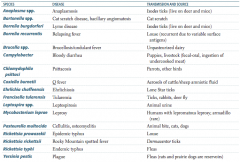
Francisella tularensis (also via ticks and deer fly)
- Tularemia |
|
|
Which zoonotic species is transmitted by animal urine? Disease?
|

Leptospira species
- Leptospirosis |
|
|
Which zoonotic species is transmitted by armadillos? Disease?
|

Mycobacterium leprae
- Leprosy - Also spread by humans with lepromatous leprosy |
|
|
Which zoonotic species is transmitted by animal bites (cats, dogs)? Disease?
|

Pasteurella multocida
- Cellulitis and osteomyelitis |
|
|
Which zoonotic species is transmitted by Dermacentor ticks? Disease?
|
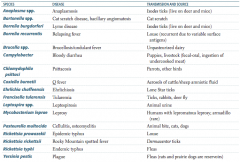
Rickettsia rickettsii
- Rocky Mountain spotted fever |
|
|
Which zoonotic species is transmitted by fleas? Disease?
|

Rickettsia typhi
- Endemic typhus Yersinia pestis - Plaque - Rats and prairie dogs are reservoirs |
|
|
Which zoonotic species has a reservoir in rats and prairie dogs? Disease?
|

Yersinia pestis
- Causes the plague - Transmitted by fleas |
|
|
Which bacteria presents as a gray vaginal discharge with a fishy smell?
|
Gardnerella vaginalis
|
|
|
Characteristics of Gardnerella vaginalis?
|

- Pleomorphic
- Gram-variable rod - Involved in vaginosis - CLUE cells or vaginal epithelial cells covered with Gardnerella bacteria are visible under the microscope (arrow) |
|
|
What causes Gardnerella vaginalis?
|
* Not sexually transmitted
- Associated with sexual activity - Overgrowth of certain anaerobic bacteria in vagina |
|
|
How is Gardnerella vaginalis treated?
|
Metronidazole or (to treat anaerobic bacteria) Clindamycin
|
|
|
What are the vector-born illnesses? Vector?
|
- Rocky Mountain Spotted Fever - tick is vector and carries Rickettsia rickettsii
- Typhus - endemic vector is fleas (R. typhi) and epidemic vector is human body louse (R. prowazekii) - Ehrlichiosis - tick is vector and carries Ehrlichia - Anaplasmosis - vector is tick and carries Anaplasma - Q fever - no arthropod vector, Coxiella burnetii spread via tick feces and cattle placenta |
|
|
How do you treat all Rickettsial diseases and vector-borne illnesses?
|
Doxycycline
|
|
|
In which Rickettsial diseases and vector-borne illnesses is a rash common?
|
Rash common:
- Rocky Mountain spotted fever (Rickettsia rickettsii - tick) - Typhus (R. typhi - fleas (endemic); R. prowazekii - human body louse (epidemic)) |
|
|
In which Rickettsial diseases and vector-borne illnesses is a rash rare?
|
Rash rare:
- Ehrlichiosis (Ehrlichia - tick) - Anaplasmosis (Anaplasma - tick) - Q fever (Coxiella burneii - tick feces and cattle placenta) |
|

Which bacteria causes a rash that typically starts at wrists and ankles and then spreads to trunk, palms, and soles? Where is it more common?
|
Rickettsia rickettsii (Rocky Mountain Spotted Fever)
- Primarily in S. Atlantic states, especially N. Carolina |
|
|
Characteristics of Rickettsia rickettsii?
|
Obligate intracellular organisms
- Requires CoA and NAD+ because they can't synthesize ATP |
|
|
What is the classic presentation of Rocky Mountain Spotted Fever?
|
Triad: headache, fever, rash (vasculitis)
|
|
|
In which infections is there a "palms and soles" rash?
|
CARS = you drive CARS using your palms and soles
- Coxsackievirus A infection (hand foot and mouth disease) - Rocky mountain spotted fever - 2° Syphilis (systemic) |
|
|
What are the different causes of Typhus? How do they differ?
|
Rickettsia typhi
- Endemic - Spread by fleas Rickettsii prowazekii - Epidemic - Human body louse |
|
|
What are the symptoms of Typhus?
|
Rash starts centrally (trunk) and spreads out, SPARING the palms and soles
|
|
|
What are the characteristics of Ehrlichiosis?
|

- Caused by Ehrlichia - vector is tick
- Monocytes with morulae (berry like inclusions) in cytoplasm (picture) - Rarely presents with a rash |
|

Which disease is pictured: monocytes with morulae (berry-like inclusions) in cytoplasm?
|

Ehrlichiosis - caused by Ehrlichia (vector is a tick)
|
|
|
What are the characteristics of Anaplasmosis?
|
- Caused by Anaplasma, vector is tick
- Granulocytes with morulae in cytoplasm - Rarely presents with rash |
|
|
Which disease is characterized by granulocytes with morulae in cytoplasm?
|
Anaplasmosis - caused by Anaplasma (vector is tick)
|
|
|
What are the characteristics of Q fever?
|
- Caused by Coxiella burnetti (can survive outside in its endospore form)
- No arthopod vector - Tick feces and cattle placenta release spores that are inhaled as aerosols - Presents as pneumonia - Rarely presents with rash |
|
|
Which bacteria has Elementary bodies and Reticulate bodies?
|
Chlamydiae
|
|
|
What are the requirements of Chlamydiae?
|
Obligate intracellular organisms - cannot make their own ATP
- Cytoplasmic inclusions seen on Giemsa or fluorescent antibody-stained smear - Chlamydial cell wall is unusual in that it lacks muramic acid |
|
|
What kind of infections does Chlamydiae cause?
|

Mucosal infections
- C. trachomatis causes reactive arthritis (Reiter syndrome), follicular conjunctivitis (picture), non-gonococcal urethritis, and PID - C. pneumoniae and C. psittaci cause atypical pneumonia (aerosol transmission) |
|
|
What are the two forms of Chlamydiae?
|
- Elementary Body (small dense) is "Enfectious" and "Enters" cells via "Endocytosis" where it transforms into a Reticulate Body
- Reticulate Body "Replicates" in cell by fission; "Reorganizes" into Elementary Bodies |
|

Which bacteria causes reactive arthritis (Reiter syndrome), follicular conjunctivitis (picture), non-gonococcal urethritis, and PID?
|
Chlamydiae trachomatis
|
|
|
Which bacteria causes atypical pneumonia and is transmitted by an aerosol?
|
Chlamydiae pneumoniae and Chlamydiae psittaci (notable for an avian reservoir)
|
|
|
How do you treat Chlamydiae infections?
|
Azithromycin (favored because one time treatment) or Doxycycline
|
|
|
How do you diagnose Chlamydiae infection?
|
Lab: cytoplasmic inclusions seen on Giemsa stain or fluorescent antibody-stained smear
|
|
|
What are the Chlamydiae trachomatis serotypes?
|
- Types A, B, and C
- Types D-K - Types L1, L2, and L3 |
|
|
Which serotypes of Chlamydiae trachomatis cause chronic infection and can cause blindness due to follicular conjunctivitis? Other characteristics?
|
Types A, B, and C
- Africa - Blindness - Chronic Infection |
|
|
Which serotypes of Chlamydiae trachomatis cause urethritis / PID, ectopic pregnancy, neonatal pneumonia (staccato cough), and neonatal conjunctivitis?
|
Types D-K (everything else)
- Neonatal disease can be acquired during passage through infected birth canal |
|
|
Which serotypes of Chlamydiae trachomatis cause Lymphogranuloma Venereum? Symptoms?
|
Types L1, L2, and L3
- Small, painless ulcers on genitals - Swollen, painful inguinal lymph nodes that ulcerate (buboes) - Treat with doxycycline |
|
|
Which bacteria is the classic cause of atypical "walking pneumonia"?
|
Mycoplasma pneumoniae (more common in patients < 30 years old; common outbreaks in military recruits and prisons)
|
|
|
What are the symptoms of "walking pneumonia"? When is this more common? Cause?
|
- Insidious onset
- Headache - Non-productive cough - Patchy or diffuse interstitial infiltrate - X-ray looks worse than patient - More common in patients < 30 years old - Frequent outbreaks in military recruits and prisons - Cause: Mycoplasma pneumoniae |
|
|
What are the lab results for a patient with "walking pneumonia" caused by Mycoplasma pneumoniae?
|
- X-ray looks worse than patient (patchy or diffuse interstitial infiltrate)
High titer of cold agglutinins (IgM), which can agglutinate or lyse RBCs - (remember it is cold in Moscow) - Grows on Eaton agar |
|
|
How do you treat "walking pneumonia" caused by Mycoplasma pneumoniae?
|
Macrolide, Doxycycline, or Fluoroquinolone
(penicillin ineffective since Mycoplasma have no cell wall) |
|
|
Why will penicillin be ineffective in a case of walking pneumonia?
|
Typical cause is Mycoplasma pneumoniae (which has no cell wall so penicillin will be ineffective)
|
|
|
Characteristics of Mycoplasma pneumoniae?
|
- No cell wall
- Not seen on Gram stain - Bacterial membrane contains sterols for stability |

